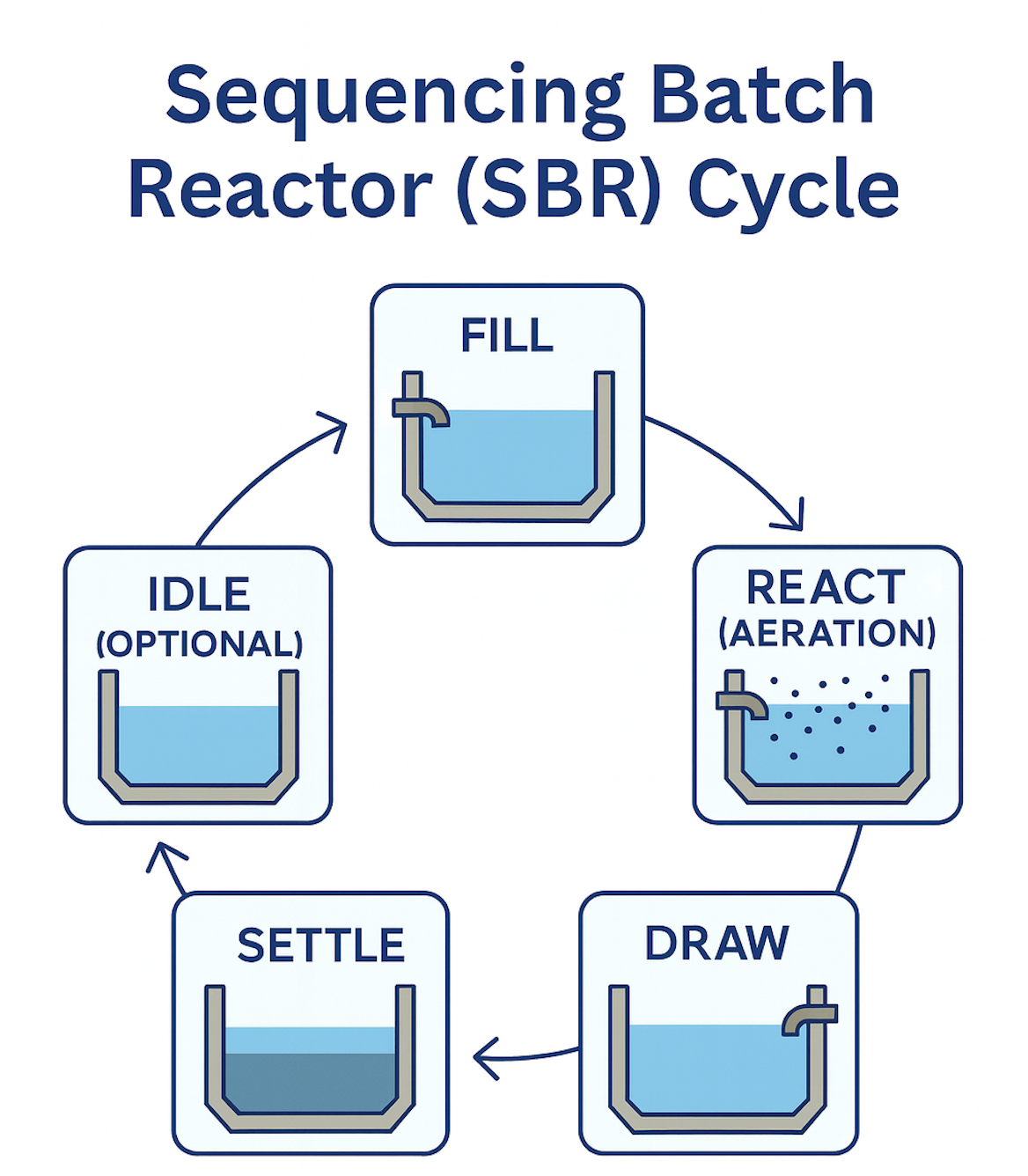Understanding the Sequencing Batch Reactor (SBR): A Step-by-Step Guide

Wastewater treatment is an essential process for protecting public health, preserving the environment, and ensuring sustainable water use. Among the various treatment technologies, the Sequencing Batch Reactor (SBR) stands out for its flexibility, compact design, and ability to achieve high treatment efficiency in a wide range of applications.
Unlike conventional continuous-flow activated sludge systems, SBRs operate in time-sequenced steps within the same tank. This means the same basin is used for all the main treatment processes—filling, aeration, settling, and decanting—rather than having separate tanks for each stage.
What Makes SBR Unique?
The SBR is essentially a fill-and-draw system. Raw wastewater enters the tank, goes through aeration and biological treatment, solids settle out, and then the treated water is decanted—all before the next batch begins.
Because each phase is carefully controlled, operators can tailor the process for carbon removal, nitrification, denitrification, or phosphorus removal simply by adjusting cycle times and aeration patterns.
This flexibility makes SBRs suitable for:
- Municipal wastewater treatment in small to medium-sized communities.
- Industrial wastewater treatment (e.g., from food processing, dairy, textile, and chemical industries).
- Decentralized and rural systems.
- Seasonal or variable-load facilities, such as resorts or military camps.
The Five Operational Phases of an SBR
An SBR cycle typically consists of five distinct stages:
1. Fill
Wastewater is introduced into the tank, which still contains biomass from the previous cycle. Filling strategies may vary:
- Static Fill: No mixing or aeration, promoting denitrification.
- Mixed Fill: Mixing without aeration for anoxic conditions.
- Aerated Fill: Immediate oxygen supply for carbon oxidation and nitrification.
2. React (Aeration)
Air is supplied via diffusers or mechanical aerators, creating aerobic conditions where microorganisms metabolize organic pollutants, ammonia, and other contaminants. The duration of this stage depends on the treatment objectives—longer aeration improves nitrification, while alternating aerobic/anoxic periods support nitrogen removal.
3. Settle
Aeration stops, and solids settle by gravity. The biomass forms a sludge blanket at the bottom, while clear treated water accumulates at the top. This stage mimics the function of a secondary clarifier in conventional systems.
4. Draw (Decant)
A decanter system—either floating or fixed—removes the supernatant (treated effluent) from the top of the tank without disturbing the settled sludge.
5. Idle
This optional stage occurs between cycles. It can be used for:
- Sludge wasting (removing excess biomass to maintain healthy microbial populations).
- Preparing the tank for the next fill.
- Buffering flow variations in multi-basin systems.
Advantages of SBR Systems
- Compact Footprint: All stages occur in one tank, reducing space requirements.
- High Treatment Quality: Capable of meeting strict discharge standards for BOD, COD, nitrogen, and phosphorus.
- Flexibility: Easy to adjust for different influent characteristics, seasonal variations, or stricter treatment targets.
- Cost Savings: Eliminates the need for separate clarifiers and reduces civil works.
- Operational Versatility: Suitable for both municipal and industrial wastewater.
- Good for Variable Flows: Handles fluctuations in flow and load better than continuous systems.
- Potential for Advanced Treatment: By modifying aeration cycles, operators can incorporate nutrient removal and even advanced polishing.
Disadvantages of SBR Systems
- Requires Skilled Operation: Precise control over timing and aeration is necessary to maintain efficiency.
- Batch Nature: Continuous inflow is not possible in single-tank systems—storage or equalization may be needed.
- Complex Automation Needs: Typically requires a reliable control system for managing phases.
- Energy Consumption: Aeration phases can be power-intensive, especially for nitrification.
- Not Always Ideal for Large Cities: Very high flows require multiple reactors operating in parallel.
- Mechanical Components: Decanters, mixers, and blowers need regular maintenance to avoid failures.
Innovations: Aerobic Granular Sludge in SBRs
A modern advancement in SBR technology is aerobic granular sludge. These dense, spherical microbial aggregates settle much faster than conventional flocculent sludge, allowing:
- Shorter settling times.
- Higher biomass concentrations.
- Improved simultaneous removal of organic matter, nitrogen, and phosphorus.
- Smaller reactor volumes for the same treatment capacity.
This development pushes SBR technology into the realm of next-generation wastewater treatment—more efficient, more compact, and potentially more cost-effective.
Summary Table
| Phase | Description |
|---|---|
| Fill | Wastewater enters tank; mixing/aeration strategy chosen |
| React | Biological treatment under aerobic/anoxic/anaerobic modes |
| Settle | Solids separate by gravity; clear water rises to top |
| Draw | Decanter removes treated effluent |
| Idle | Sludge wasting and prep for next cycle |
Final Thoughts
SBRs are a robust and adaptable wastewater treatment option that bridge the gap between simplicity and high performance. Their ability to handle varying loads, meet strict effluent requirements, and integrate nutrient removal makes them a preferred choice for many engineers and plant operators.
However, their success depends on good design, proper automation, and skilled operation. As technology advances—especially with the adoption of aerobic granular sludge—SBRs are likely to remain at the forefront of efficient and sustainable wastewater treatment solutions.
